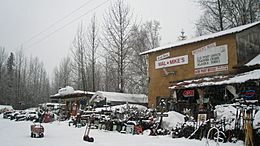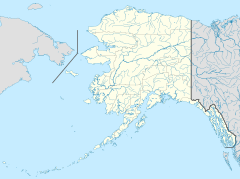Trapper Creek, Alaska facts for kids
Quick facts for kids
Trapper Creek, Alaska
|
|
|---|---|
 |
|

Location in Matanuska-Susitna Borough and the state of Alaska
|
|
| Country | United States |
| State | Alaska |
| Borough | Matanuska-Susitna |
| Area | |
| • Total | 327.81 sq mi (849.02 km2) |
| • Land | 320.04 sq mi (828.90 km2) |
| • Water | 7.77 sq mi (20.12 km2) |
| Elevation | 351 ft (107 m) |
| Population
(2020)
|
|
| • Total | 499 |
| • Density | 1.56/sq mi (0.60/km2) |
| Time zone | UTC-9 (Alaska (AKST)) |
| • Summer (DST) | UTC-8 (AKDT) |
| ZIP code |
99683
|
| Area code(s) | 907 |
| FIPS code | 02-78680 |
| GNIS feature ID | 1417100 |
Trapper Creek is a small community in Alaska, United States. It is known as a census-designated place (CDP), which means it's an area defined for counting people. Trapper Creek is located near the bigger city of Anchorage. It is also called the "southern gateway" to the amazing Denali State Park. In 2020, about 499 people lived there.
Contents
History of Trapper Creek
Trapper Creek got its name from two brothers, Oliver Rabidoux and Noah Rabidoux. They were the first people to live there permanently and worked as trappers.
Building Roads
In 1917, construction began on Petersville Road, one of the two main roads in the area. The other important road, the Parks Highway, was finished much later, in 1971. These roads helped connect Trapper Creek to other places.
Geography and Location
Trapper Creek is located in the Matanuska-Susitna Borough of Alaska. It sits at an elevation of about 107 meters (351 feet) above sea level. You can find it at mile 114.5 on the Parks Highway, just south of Denali State Park.
Where is Trapper Creek?
The community is spread out along the Parks Highway. It is about 15 miles (24 km) north of Talkeetna Junction. Trapper Creek is also at the intersection of Petersville Road. This road leads west into areas known for mining, prospecting, and outdoor fun in the foothills of the Alaska Range.
Land and Water
The United States Census Bureau says that Trapper Creek covers a total area of about 849 square kilometers (327.8 square miles). Most of this area, about 829 square kilometers (320.0 square miles), is land. The rest, about 20 square kilometers (7.8 square miles), is water. The eastern edge of Trapper Creek is bordered by two rivers: the Chulitna River and the Susitna River.
Population and People
Trapper Creek first appeared on the U.S. Census in 1990 as a census-designated place (CDP).
| Historical population | |||
|---|---|---|---|
| Census | Pop. | %± | |
| 1990 | 296 | — | |
| 2000 | 423 | 42.9% | |
| 2010 | 481 | 13.7% | |
| 2020 | 499 | 3.7% | |
| U.S. Decennial Census | |||
Who Lives in Trapper Creek?
In 2000, there were 423 people living in Trapper Creek. These people lived in 182 households, and 123 of these were families. The population density was about 0.60 people per square kilometer (1.56 people per square mile).
Most of the people in Trapper Creek were White (87.71%). There were also people who identified as Native American (8.27%), Asian (0.47%), and Black or African American (0.24%). About 3.31% of the people were from two or more racial backgrounds. A small number, 1.18%, were Hispanic or Latino.
Households and Families
About 24.7% of the households in 2000 had children under 18 living with them. More than half, 52.2%, were married couples living together. About 8.2% of households had a female head with no husband present.
The average household had 2.32 people, and the average family had 2.74 people. About 28.0% of all households were made up of individuals living alone. Only 5.5% of households had someone living alone who was 65 years old or older.
Age Groups
The population in Trapper Creek was spread out across different age groups. About 22.7% of the people were under 18 years old. About 39.0% were between 45 and 64 years old, and 9.5% were 65 years or older. The average age in Trapper Creek was 44 years. For every 100 females, there were about 121.5 males.
Income in Trapper Creek
In 2000, the average income for a household in Trapper Creek was $27,031 per year. For families, the average income was $34,250 per year. The average income per person in Trapper Creek was $18,247. About 24.7% of the population lived below the poverty line. This included 16.7% of those under 18 and 22.6% of those 65 or older.
See also
 In Spanish: Trapper Creek (Alaska) para niños
In Spanish: Trapper Creek (Alaska) para niños


